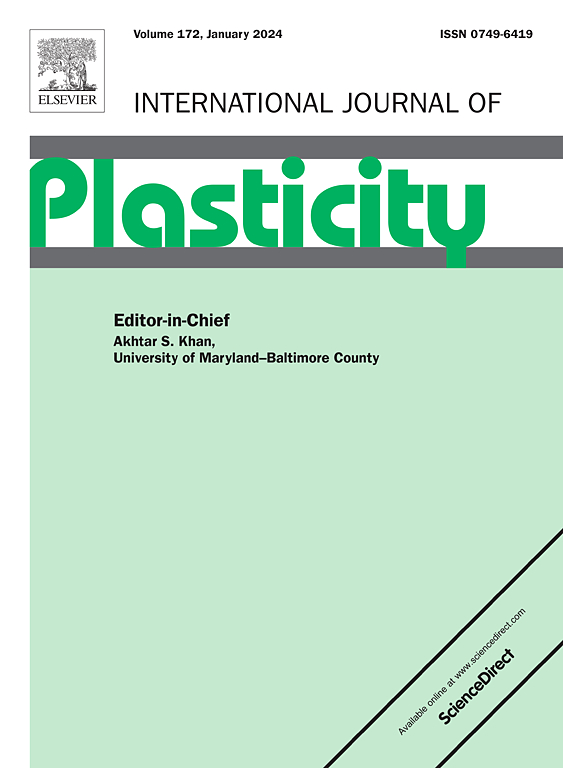Anisotropic phase-field crystal plasticity modelling of fracture in nickel-based superalloy
IF 12.8
1区 材料科学
Q1 ENGINEERING, MECHANICAL
引用次数: 0
Abstract
Accurately predicting anisotropic damage evolution in crystalline metals remains a challenging topic due to the multiscale nature of fracture. Microstructures play a critical role in influencing crack deflection at the macroscale. To study the relations among anisotropic deformation, crack initiation and propagation, an anisotropic phase-field crystal plasticity model has been developed for nickel-based superalloys. This model differs from conventional approaches in formulating the critical energy release rate as a function of preferentially activated slip or cleavage planes, rather than merely considering it as an isotropic quantity. This development not only allows effective representation of crack initiation due to local anisotropy introduced by slip activation, but also enables a more accurate representation of crystallography-dependent fracture behavior.
The performance of proposed method will be demonstrated to characterize crack initiation and propagation in nickel-based single-crystal and polycrystal superalloys. The proposed anisotropic phase field method has been found to be consistent with generalized maximum energy release rate criterion. The findings highlight the significant influence of crystallographic orientation on the crack formation in single crystals. Increased geometrically-necessary dislocation (GND) density has been observed along the activated slip directions, particularly for those near the crack tip. The model capability has also been exhibited in characterizing crack deflection within polycrystalline microstructures. The model is further verified against available experiments reported in recent literatures, by virtue of simultaneously comparing the stress-strain response and crack growth.
镍基高温合金断口各向异性相场晶体塑性模拟
由于断裂的多尺度性质,准确预测金属晶体的各向异性损伤演化仍然是一个具有挑战性的课题。微观结构在宏观尺度上对裂纹挠度的影响至关重要。为了研究各向异性变形与裂纹萌生和扩展之间的关系,建立了镍基高温合金各向异性相场晶体塑性模型。该模型与传统方法的不同之处在于,它将临界能量释放率表述为优先激活滑移面或解理面的函数,而不仅仅是将其视为各向同性的量。这一发展不仅可以有效地表示由滑移激活引入的局部各向异性引起的裂纹起裂,而且可以更准确地表示晶体学相关的断裂行为。该方法可用于镍基单晶和多晶高温合金的裂纹萌生和扩展。所提出的各向异性相场法符合广义最大能量释放率准则。研究结果强调了晶体取向对单晶裂纹形成的重要影响。在激活滑移方向上观察到几何必要位错(GND)密度的增加,特别是在裂纹尖端附近。该模型在表征多晶微观结构中的裂纹挠度方面也表现出了一定的能力。通过同时比较应力应变响应和裂纹扩展,与现有文献的实验结果进一步验证了模型的正确性。
本文章由计算机程序翻译,如有差异,请以英文原文为准。
求助全文
约1分钟内获得全文
求助全文
来源期刊

International Journal of Plasticity
工程技术-材料科学:综合
CiteScore
15.30
自引率
26.50%
发文量
256
审稿时长
46 days
期刊介绍:
International Journal of Plasticity aims to present original research encompassing all facets of plastic deformation, damage, and fracture behavior in both isotropic and anisotropic solids. This includes exploring the thermodynamics of plasticity and fracture, continuum theory, and macroscopic as well as microscopic phenomena.
Topics of interest span the plastic behavior of single crystals and polycrystalline metals, ceramics, rocks, soils, composites, nanocrystalline and microelectronics materials, shape memory alloys, ferroelectric ceramics, thin films, and polymers. Additionally, the journal covers plasticity aspects of failure and fracture mechanics. Contributions involving significant experimental, numerical, or theoretical advancements that enhance the understanding of the plastic behavior of solids are particularly valued. Papers addressing the modeling of finite nonlinear elastic deformation, bearing similarities to the modeling of plastic deformation, are also welcomed.
 求助内容:
求助内容: 应助结果提醒方式:
应助结果提醒方式:


